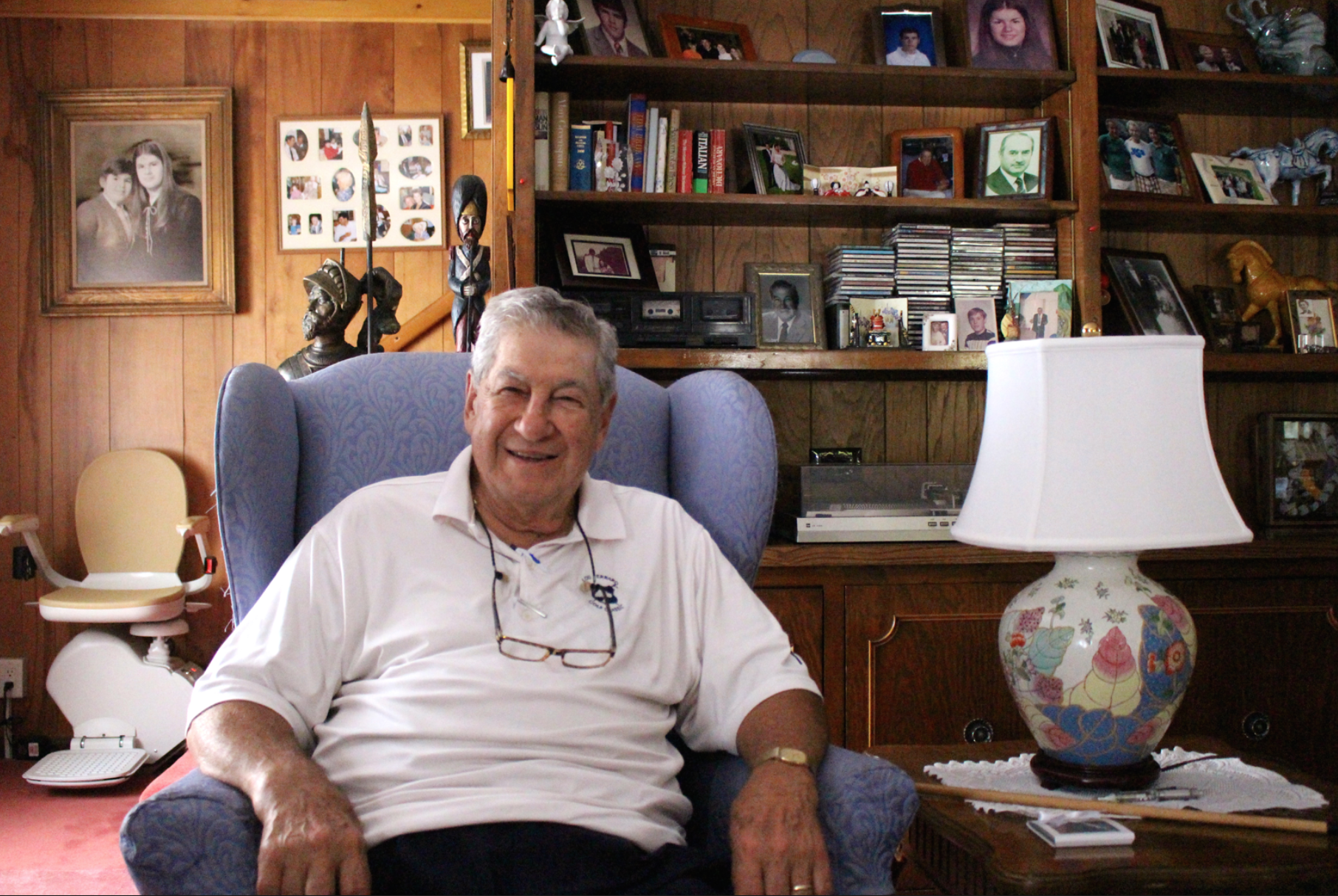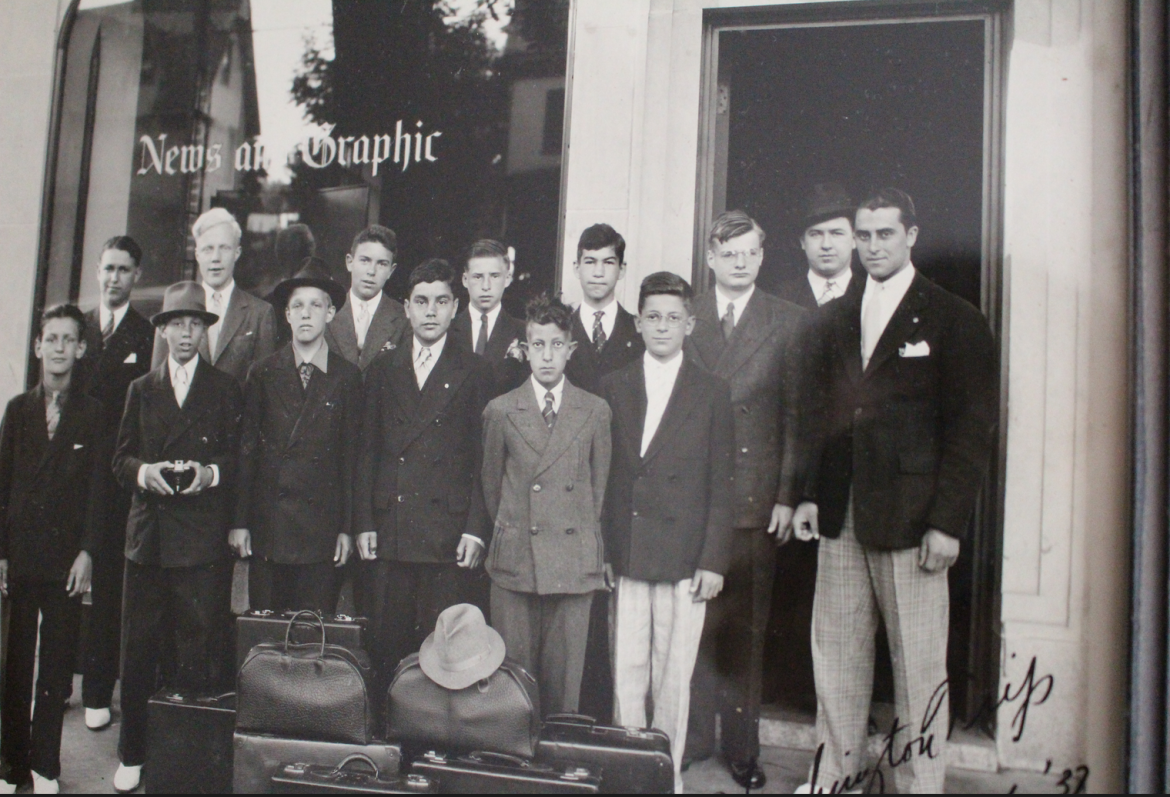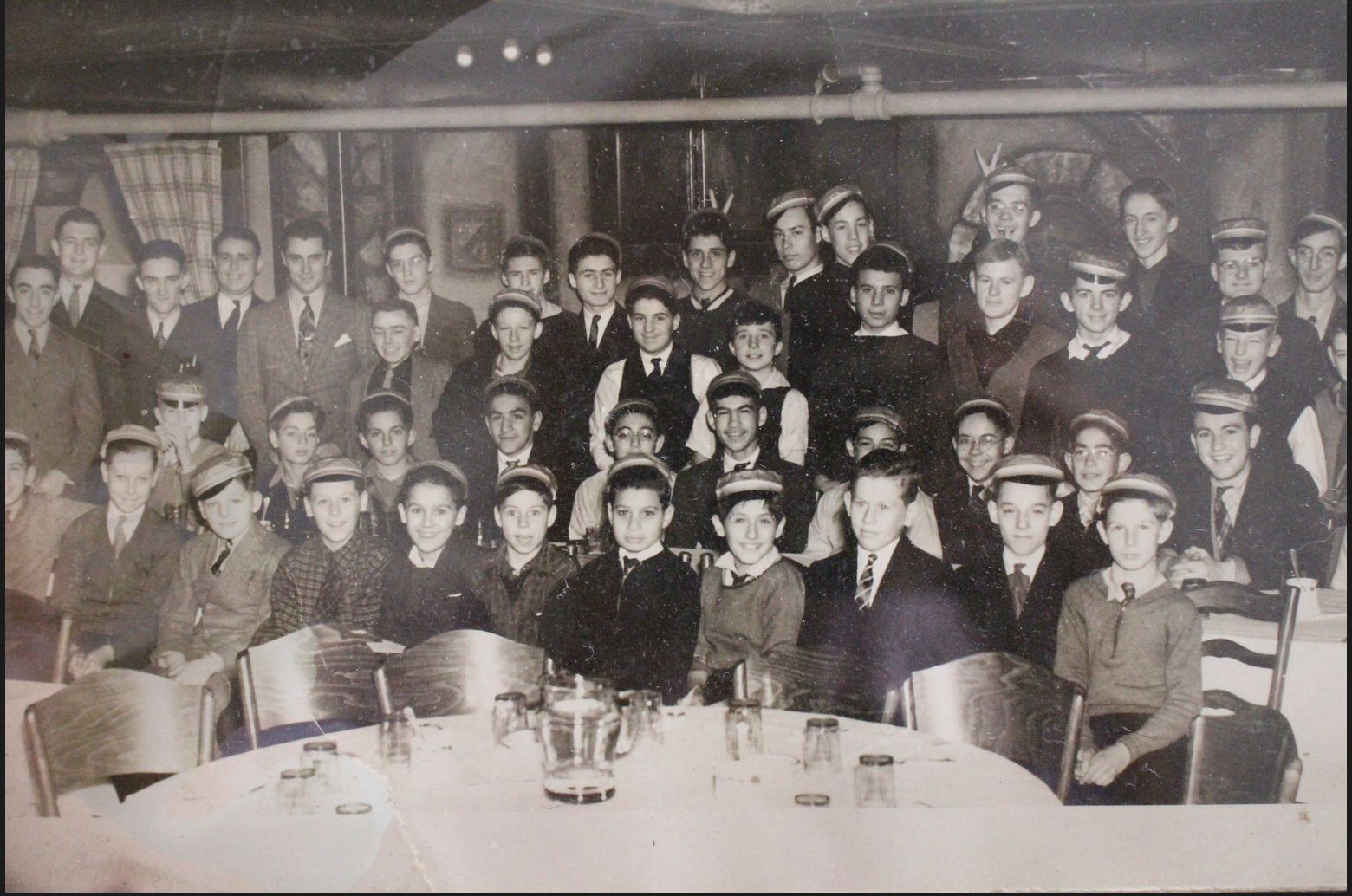Lou Caravella passed away on Thursday night, January 2, 2020.
This article was originally published on September 7, 2015
Born and raised in Greenwich, Lou Caravella, who turns turns 89 in October, describes himself as “one of the few natives still left.” He shares his memories of being a seven-year-old paper boy during the Great Depression, walking up and down Greenwich Avenue selling the News & Graphic, precursor to Greenwich Time. In a black-and-white photo of himself at the age of seven, his enthusiastic grin is unmistakable, though the knee socks and rubber shoes have since been consigned to history.
The photo is one of several Mr. Caravella intends to donate to the Historical Society of Greenwich, preserving both memories of his boyhood and milestones in the evolution of the local news business.

At home in Cos Cob, Lou Caravella, a lifelong resident of Greenwich shared his memories of working as a paperboy beginning at the age of seven. He attended GHS, and was later drafted into the service at the end of World War II. For many years he ran a thriving stationery store in Cos Cob, before becoming Greenwich’s tax collector. Credit: Leslie Yager
“The paper was 3¢ and you got to keep 1¢ a copy,” he said. “I sold them in front of Havemeyer and the Post Office, and I walked the Avenue. Then when the trains came in at night, we used to sell them at the Greenwich train station.”
When he was a bit older, Caravella became a carrier boy with a regular route. “They would adjust your rate according to your subscriptions. The more people who paid for a subscription, the more you earned.”

Dressed in their finest, luggage packed, the successful carrier boys are set for a three-day trip to Washington, DC in 1937.
Evidence of Caravella’s salesmanship is chronicled in a series of photos taken during trips he earned as incentives for selling subscriptions. “You had to sell five newspaper subscriptions to get the trip to Washington DC,” he said. Another photo, taken at the hotel that is now the spot of J House, captures of all the paper boys dressed up for a Christmas party.

A photo taken at the hotel that is now the spot of J House, captures of all the paper boys dressed up for the Christmas party.
Of a memorable trip he won to New York City in 1936, Caravella explained it was an opportunity he would not have otherwise had. “We left on a Friday and came home on Sunday,” he said of the group of successful young boys who were treated to a stay at the venerable Taft Hotel on 50th Street in Times Square.
“Your eyes popped out of your head,” he said of the theaters where big bands played. “Count Basie, Glenn Miller, Tommy Dorsey,” he said, listing big bands of the era. The three-day visit allowed the boys to explore the city, including Rockefeller Center, and pass hours in a games arcade. “Everything was a nickel and we played all kinds of games,” he said. “These were things I would never have done if not for the paper and all the incentives to sell subscriptions. You knocked on doors and asked the people if they wanted to subscribe to the paper. You got a point for each subscription. When you got five points, you got to go on a trip.”
“We also went on strike,” he recalled, explaining the action was triggered when a new circulation boss, John Conners, came on board, firing circulation managers, Frank Todero and Len Fontaine.
“So all the carriers in central Greenwich went on strike for three days,” Caravella said. “Then they got rehired as assistant circulation managers,” he said, referring to Todero and Fontaine. Of the new boss, Caravella said, “He was a hell of a guy once you got to know him. When you’re young you don’t know the difference,” he said of his thoughts during the strike he participated in as a young boy. “He was a fine gentleman,” Caravella said of Conners. “He used to take us to the city. We had a great time.”
Mr. Caravella worked for the paper until he was about 16 or 17. “The war was on and I was a manager in the circulation department working in the mail room,” he said. “We were sending all the papers to the boys in the service,” he recalled, describing how the staff would roll up the newspapers and stamp the addresses on the brown paper wrappers and take them over to the Post Office. “We made a paste of flour and water and kept it in a bucket,” Mr. Caravella recalled. “We’d mail the newspapers all over the world. Anywhere G.I.’s were.”
Another memory was of news photographer, Nick Verderosa. “We had a dark room. He’d come in and develop all the photos,” Caravella said. “When that light was on, you did not dare open that door.”
Mr. Caravella described the Linotype operators’ tasks. “They’d lock the type onto the wheels of the press in a semi-circle. Then, as the paper ran through, the type would print onto it,” he said, recalling how as a young boy, he watched the process with a sense of awe.
Mr. Caravella enlisted in the military at the age of 17. “They had a drive to recruit at Greenwich High School,” recalled the member of the GHS class of 1944, who kept his grades up (with the exception of short hand) while working jobs at Kings stationery and for the News & Graphic. “I passed my physical and I waited to be drafted. I wanted to be a pilot,” he recalled, having enjoyed assembling and flying balsa wood airplanes and flying them in Bruce Park as a boy.
“They were looking for navigators, bombadiers and pilots in the Air Force,” he recalled, adding that his arrival in the armed services coincided with the end of the war. “I was sent to Germany and France. Starting at the Hermann Göring Air Force Base,” he said referencing Hitler’s commander-in-chief of the Luftwaffe in 1935. Next, Caravella went to France to an area near Versailles, before moving on to Paris.
“They sent me to mechanic school,” he said, adding that his next job was as quarter master. “The best job I ever had. We took care of all the supplies. We filled orders and went to the main depot to pick up new supplies. When the guys went home, they would turn in their uniforms. We called it the ‘Repo Depot,'” he said.
Jumping back in time, Mr. Caravella recalls some of the joys of growing up in Greenwich when there was open air ice skating and people simply walked to their destinations. “When that was frozen, it went 10 inches deep,” he said of the big pond at Pomerance.
“Pomerance was always the first place to freeze and that was where the GHS hockey team practiced,” Mr. Caravella said. Recalling that the outdoor skating was all possible because the Pomerance family’s generosity, he said, “Ralph and Josephine Pomerance were very civic minded. They let everyone skate on that pond until at one point it got a bit too rowdy.”
Lou and Judy Caravella’s four children all were able to walk to Central Middle School, Greenwich High School, and, of course, to Pomerance to go ice skating on the pond.
From Rinky-Dink Store to Hub of Cos Cob
As luck would have it, the Caravella children were born in alternating genders: girl, boy, girl, boy. As the four children grew up, their father Lou mostly worked at his stationery store. “In the beginning I was there all the time, working 6:00am til 11:00pm by myself,” he recalled. He said his wife Judy was busy with the quick succession of babies, and didn’t initially enjoy working in the store. But that all changed.
“When I bought the store, my wife hated it. Time prevailed, and this little rinky-dink store became the hub of Cos Cob,” he said, describing the store as very narrow and just 35 ft deep. It was located in the block just to the west of Cos Cob School, next to where Arcuri’s is today.
Takes a Licking and keeps Ticking
One unique memory Mr. Caravella had involves Timex watches. “The salesman, Harry, would come calling. They sold me Christmas items, toys and sundries,” he recalled. “I remember the salesman came in with six Timex watches on a board,” he recalled, adding that he didn’t think anyone would buy a watch at a stationery store, but the watches were on consignment. “In two days they were all sold. Next, he brought me a dozen. In two days they were gone too.”
“As I told my kids as they grew up, ‘It’s the people who walk through the front door who make you a success,” he recalled. “We became the ‘Do-It Store,” nobody else sold service.”

For 35 years, Lou ran Post Stationery at 228 East Putnam Ave, but it was always known simply as “Lou’s,” a place where service was paramount. When he first opened the store he was there every day from 6:00am til 11:00pm.
“April and October, it was like ants in a colony in that store,” he recalled. “We replaced batteries in cameras, fixed flashlights, replaced watch straps and batteries. But there was never a service charge,” Mr. Caravella said. “We also wrapped packages to be mailed he said. There was never a charge for that.”
Mr. Caravella recalled the arrival of Caldor at the intersection of East Putnam Ave and Sound Beach Ave. “Caldor undersold us,” he said of the now defunct discount department store chain that operated regionally beginning in the early 1950s. “But they didn’t give service. We built all of our business on service,” he said.
Batteries Not Included
Mr. Caravella would put on new watch straps and reset the time on watches. He never charged for the service. On holidays the store would close at 2:00pm, but, Caravella said, “What goes around, comes around. We stayed open, and people of Cos Cob were very good to us,” he recalled. “On holidays we were the only store open. This way, if you ran out of something, we were there. On Christmas, by late morning, families would come in to Lou’s for batteries.”
Easter was another busy time at Lou’s. “We made up to 300 baskets for Easter, each made by Lou or Judy Caravella,” he said, adding that the baskets would be filled to suit the tastes of the recipient. “We would fill the baskets with football or baseball cards and top them with candies.” The Caravellas sold sturdy plywood baskets with bamboo handles. Local families would invest in a basket and bring it back time and again to be refilled.
In the summer, the Caravellas assembled sand pails with small shovels and sand molds. “We’d top it off with candy or a toy,” he recalled.
And, oh, the candy. While Riverside had Ada’s Variety, Cos Cob had “Lou’s” and his penny candy cabinet was a popular spot for children.
“You’d have a group of children come in, and one would have a nickel. He’d pick out all the candy and share it with his friends. We had licorice, Tootsie Rolls, Bazooka bubble gum and Mary Jane’s,” he said, adding that yes, they also sold the candy dots on sheets of paper. “They’d deliberate — ‘Well, this one is two for a penny, and so on.”
“They loved the wax bottles with the juice inside,” Caravella recalled. “The sidewalk outside the store was covered in wax, and when it was real hot outside, it would get sticky.”
At Christmas and Easter the store was constantly busy. “We were packed. It was body to body,” he said.
After 35 years running Lou’s, not having closed for a single day, Mr. Caravella sold the store in 1988. He and Judy took a life-changing world tour. Over the years they hosted fourteen international students through the Cos Cob Rotary Club. “There was a standing program with Greenwich High School,” Caravella recalled. “It didn’t alter the enrollment. It was one student out; one student in.”
Forever a Problem-Solver
After selling the stationery store in 1988, Mr. Caravella said he took a single summer off. “By about October I said, ‘I gotta get a part-time job.’ They were looking for a clerk at the hardware store at the other end of town,” he said, referring to the then New England Hardware Store which operated adjacent to Wendy’s. “They hired me on the spot. It was a great experience,” he said, adding that 90% of the people who go to the hardware store have a problem, and he was accustom to finding solutions.
After working at the hardware store for five years, the store closed and Caravella went to work at the liquor store with his son for three years. “I learned a lot about the wine business,” he said.
Along the way, Caravella, a Democrat, served on what was then the Board of Tax Review. When Jim Branca, tax collector for the Town of Greenwich for twenty years passed away, Mr. Caravella was recruited to finish his term. Dick Bergstresser and Stephanie Sanchez, Democrats, were selectmen at the time. “Stephanie called me up and said, ‘How’d you like to be tax collector?'” he recalled, referring to the interim appointment for the remainder of Mr. Branca’s term.
When the term expired, Mr. Caravella ran for the position as a Democrat. “Lo and behold I was nominated, and I was challenged by a number of Republicans. I lodged a big campaign and raised money to run ads in the paper and pay for robocalls. The slogan was ‘Vote for Lou,” and I won by 62 votes,” he recalled. “But anything under 100 voted meant an automatic recall,” he said. When the recount was tallied, Mr. Caravella had won by 55 votes.
The second time Caravella ran for the tax collector office, he won by 2,000 votes. The third, and final time he ran, was a different story. “I ran unopposed,” he said. In total Mr. Caravella served Greenwich in the capacity of tax collector for 11 years. In 2001, at the age of 83, he decided not to run again, and to enjoy some hard earned free time.
An invaluable resource for Greenwich history buffs, this past June, as part of Greenwich Historical Society’s 375th anniversary year celebration, Mr. Caravella gave a talk entitled “Cos Cob, Past and Present.” The special guest speaker’s talk was fully booked, and, as with many of the other neighborhood tours that filled to capacity, one can only hope they will be repeated.
See also:
Greenwich Crossing Guard Set for New Year: Honk if You Love Bob Lynagh
Hitting the Jackpot at Scarpelli’s Sausage Store
32nd Anniversary of Grim Event: Collapse of Mianus River Bridge, June 28, 1983
Evaristo Notwithstanding, Greenwich Officials Selected Chickahominy for Incinerator in 1930s
Longing for the Clam Box on Hot Summer Nights in Greenwich
How Far Would You Go for Parking in Greenwich? 1969 “Lewis-Elm St Parking Deck” Idea Ditched